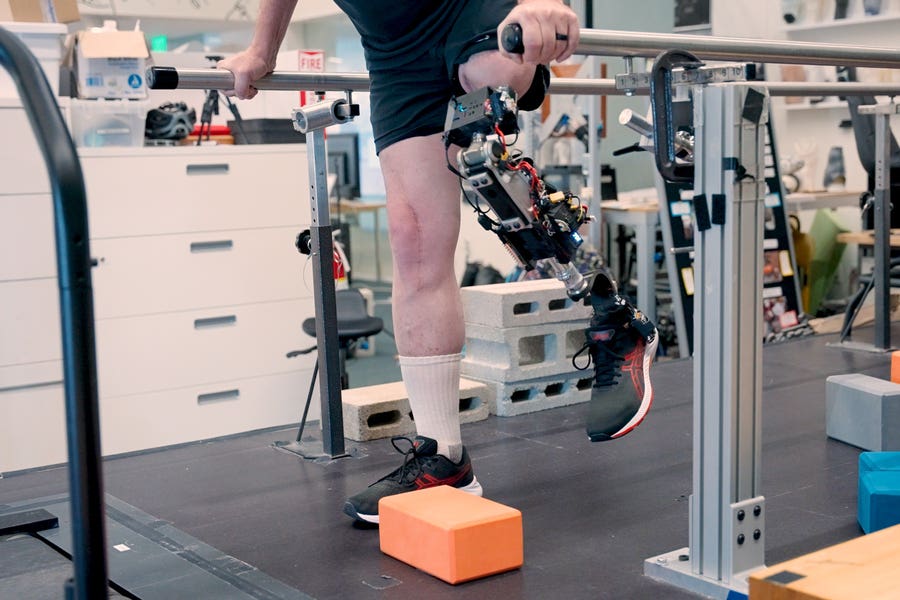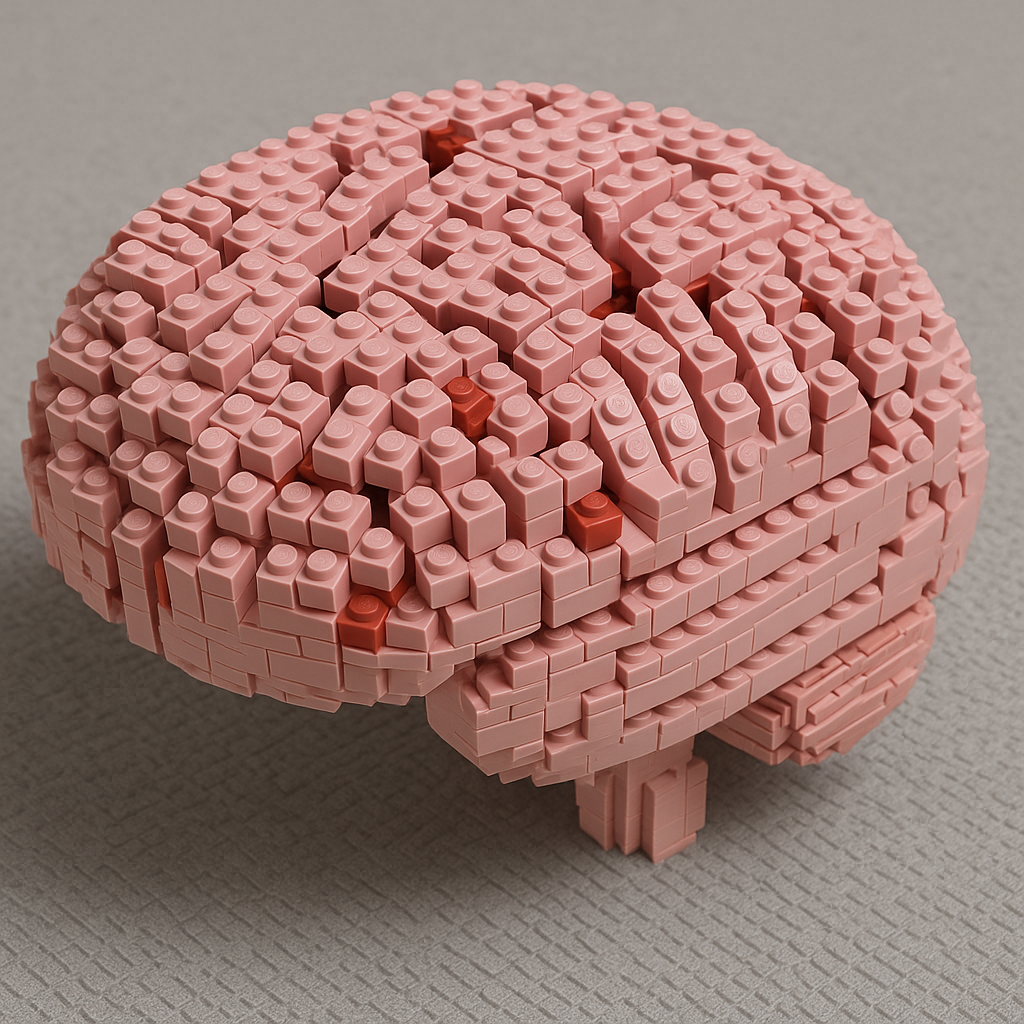MIT’s new bionic knee offers real sensation and improved mobility
MIT researchers develop a bionic knee integrating directly with muscles and bones, improving mobility and embodiment for amputees.

Using an osseointegrated mechanoneural prosthesis, the subject actively bends and straightens their phantom knee to step over an obstacle in their path. (CREDIT: MIT)
MIT researchers have introduced a groundbreaking bionic knee designed to significantly improve mobility for people with above-the-knee amputations. The innovation allows for smoother walking, easier stair climbing, and improved obstacle avoidance compared to traditional prostheses. Research findings are now available online in the journal Science.
Traditional prosthetic limbs rely on a socket in which the residual limb sits, often causing discomfort and instability. This new system directly integrates with your muscles and bones, resulting in greater control and balance. Early clinical tests suggest users feel this advanced prosthesis as an extension of their own body rather than just a mechanical device.
A New Surgical Approach
Researchers at MIT, led by Hugh Herr from the K. Lisa Yang Center for Bionics, developed an innovative surgery called the agonist-antagonist myoneuronal interface (AMI). In typical amputations, muscles that normally work in pairs to move joints become separated. This disruption makes it hard for your nervous system to detect muscle position or speed.
The AMI surgery reconnects these muscle pairs within your residual limb. This connection restores natural muscle communication and sensory feedback. "It’s not simply a tool that the human employs, but rather an integral part of self," says Herr, emphasizing the unique integration of this new system into human physiology.
Previously, Herr's lab showed that patients who had below-the-knee amputations using the AMI method experienced improved mobility. These individuals could walk faster and better navigate obstacles compared to those with traditional amputations.
Integration into Bone and Muscle
To expand these benefits for above-the-knee amputees, the team combined AMI surgery with another technique known as e-OPRA. They implanted a titanium rod directly into the femur bone at the amputation site. This implant provides superior mechanical support and stability compared to socket-based limbs.
Related Stories
- New innovation paves the way for natural feeling bionic limbs
- The first brain-controlled bionic leg revolutionizes mobility for amputees
- 5 year-old boy is youngest ever to receive bionic arm: 'I am Iron Man'
The bone implant includes 16 wires connected to muscles enhanced by AMI surgery. These wires precisely capture electrical signals generated by muscle movement. The signals travel to a robotic controller specifically designed by MIT scientists, which calculates how your prosthetic knee should move.
“Our approach directly loads the skeleton—the body's natural support system—reducing discomfort and skin infections common with sockets,” explains researcher Shu.
Testing the New Bionic Knee
In their latest study, published in 2024, MIT researchers tested the combined system, known as the osseointegrated mechanoneural prosthesis (OMP). They compared two users equipped with OMP against eight individuals who had only AMI surgery, and seven others with traditional prostheses. Each participant tested a powered knee developed by the team.
The tests included precise knee movements, climbing stairs, and stepping over obstacles. Results showed the OMP users consistently outperformed those with only AMI surgery, and significantly surpassed the traditional prosthesis users.
According to Michael Goldfarb, Director of the Center for Intelligent Mechatronics at Vanderbilt University, this innovation marks a major milestone. "This is really difficult work, and the authors deserve tremendous credit for their efforts in realizing such a challenging goal,” Goldfarb states.
Feeling Connected to Your Limb
Beyond physical tasks, researchers assessed users’ psychological experiences. They wanted to determine whether the new prosthesis felt genuinely integrated into the users' bodies.
Participants answered questions about their sense of having two legs, ownership of the prosthesis, and control over its movements. Those using the OMP consistently reported feeling more connected to their prosthetic limb, with a strong sense of control and embodiment.
"The more it's integrated, the more they're going to say the prosthesis is actually part of self," Herr explains. This connection sets the OMP apart, transforming perceptions of artificial limbs from mere tools into natural extensions of the body.
Future of Prosthetic Technology
Currently, the AMI procedure is routinely performed at Brigham and Women’s Hospital for below-the-knee amputees. Herr expects it will soon become standard practice for above-the-knee amputations as well. However, broader clinical trials of the OMP system are required for FDA approval, anticipated to take around five years.
Until now, most advanced prostheses relied on pre-programmed movements, lacking true integration with the body. The OMP represents a substantial leap forward by merging muscle and bone connections to allow intuitive limb control and versatile movement.
According to researchers, even minor sensory feedback from the body's nerves dramatically enhances mobility and agility. Future advancements could offer even greater improvements, enabling amputees to move naturally across varying terrains and challenges. Herr and his team envision a future where prosthetic limbs aren't just aids but true extensions of human capabilities, seamlessly integrated into daily life.
Other Recent Bionic Limb Developments
The landscape of bionic limb replacement is rapidly evolving, and one of the most groundbreaking innovations comes from Phantom Neuro. These pioneering muscle implant systems allow intuitive prosthetic control without brain surgery.
In a recent study involving ten participants, the implanted sensors achieved an impressive 93.8% gesture accuracy, outperforming traditional surface electrodes that are prone to instability. These implants interface directly with residual muscles, offering highly reliable and natural control, and are expected to enter clinical trials in 2025. This represents a significant step forward over earlier systems, where inconsistent signal pickup often limited responsiveness and usability.
Another transformative development is in tactile and proprioceptive feedback. Engineers have created bionic hands that not only replicate movement but also restore a sense of touch and spatial awareness. Research teams have successfully co-designed multi-synergistic robotic hands with neural decoding algorithms that allow users to feel the shape and motion of objects for the first time.
These systems decode signals from peripheral nerves and stimulate sensory fibers to recreate natural sensations—a major leap compared to plain myoelectric hands that lacked any sensory feedback, resulting in more intuitive object manipulation and safer interactions.
5G-Enabled Systems
Simultaneously, the convergence of bionics and connectivity is being accelerated by 5G-enabled systems. A recent proof-of-concept study demonstrated a cloud-connected bionic hand equipped with a camera and edge computing capabilities.
Through ultralow-latency 5G links, the system processes visual feedback in real-time (<125 ms) to help users interact with their environment intelligently. By offloading compute-heavy tasks like object recognition and predictive control, these prosthetics can be lighter, smarter, and more adaptive—a significant improvement over standalone on-board processors that struggled with power, weight, and limited AI capacity.
On the surgical and neural interface front, targeted muscle reinnervation (TMR)—developed by Dr. Todd Kuiken and Dr. Gregory Dumanian at Northwestern University—continues to make substantial strides. TMR reroutes residual nerves into alternate muscles, allowing amputees to produce multiple, independent EMG signals that intuitively control bionic limbs and provide sensory feedback through reinnervated skin areas.
This technique enables users to perform simultaneous movements—like bending the elbow while grasping—and feel basic sensations, outperforming traditional myoelectric prostheses that offered only single-channel control and no touch feedback. When paired with advanced multipurpose prosthetics, TMR users gain natural, high-fidelity control without requiring invasive implants.
Finally, mass adoption is being championed by Open Bionics, a UK-based company specializing in 3D‑printed, low-cost myoelectric arms. Founded by Joel Gibbard and Samantha Payne, Open Bionics offers the Hero Arm, the Hero Pro & Hero RGD, which are wireless, waterproof, and can operate off-limb.
With clinics now established in major US cities (including Los Angeles and Chicago), the Hero series blends personalization, reliability, and affordability. Priced much lower than high-end neuroprosthetics, this approach democratizes access to functional, customizable bionic arms for a wider population.
Together, these five innovations highlight a future where bionic limbs are not just replacements but extensions of the human body.
Note: The article above provided above by The Brighter Side of News.
Like these kind of feel good stories? Get The Brighter Side of News' newsletter.



